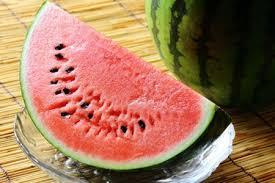
The watermelon is a large fruit, known scientifically as Citrullus lanatus.
It originates from southern Africa, and is related to cantaloupe melons, zucchinis, pumpkins, and cucumbers.
Watermelon is packed with water and nutrients, contains very few calories, and is exceptionally refreshing and juicy.
It is also a good dietary source of both citrulline and lycopene which are two very powerful plant compounds.
Eating watermelon or drinking watermelon juice may have several health benefits, including lower blood pressure, improved insulin sensitivity and reduced muscle soreness.
While watermelons are most commonly eaten fresh, they can also be made into juice or even added into smoothies.
Watermelons have a red or pink flesh, surrounded by a hard peel that is usually green with dark green stripes.
There are also varieties with white, yellow, orange, and green flesh.
They generally contain numerous small seeds, but there are also seedless varieties.
Nutrition Facts
Watermelon consists mostly of water (91%) and carbs (7.5%). It contains almost no protein or fat, and is very low in calories.
Vitamins and Minerals
Watermelon is a good source of vitamin C, and has a decent source of several other vitamins and minerals.
• Vitamin C: An antioxidant that is essential for skin health and immune function.
• Potassium: A mineral that is important for blood pressure control and heart health.
• Copper: A mineral that is most abundant in plant foods, and often lacking in the Western diet.
• Vitamin B5: Also known as pantothenic acid. This vitamin is found in almost all foods to some extent.
• Vitamin A: Watermelon contains beta-carotene, which is transformed into vitamin A in the body.
Citrulline
Watermelon is the richest known dietary source of the amino acid citrulline. The highest amount is found in the white rind that surrounds the flesh.
In the body, citrulline is transformed into the essential amino acid arginine.
Both citrulline and arginine play an important role in the synthesis of nitric oxide (NO), which helps to lower blood pressure by dilating and relaxing our blood vessels.
Arginine is also important for many organs, such as the lungs, kidneys, liver, and the immune and reproductive systems, and has been shown to facilitate the healing of wounds.
Studies have shown that watermelon juice is a good source of citrulline, and is able to increase blood levels of both citrulline and arginine considerably.
Despite being one of the best dietary sources of citrulline, one would have to consume about 5 pounds (2.3 kg) of watermelons to meet the recommended daily intake for arginine.
Lycopene
Watermelon is the best known fresh source of lycopene, a powerful antioxidant responsible for its red color.
Lycopene is used to some extent to form beta-carotene in the body, which is converted into vitamin A.
Lycopene is generally associated with tomatoes, but fresh watermelon is actually a better source of lycopene than fresh tomato.
Human studies have shown that fresh watermelon juice is effective at raising blood levels of both lycopene and beta-carotene.
Bottom Line: Watermelon is a good source of two beneficial plant compounds, the amino acid citrulline and the antioxidant lycopene.
Summary
Watermelon is an exceptionally healthy fruit.
It is loaded with citrulline and lycopene, two powerful plant compounds that have been linked to lower blood pressure, improved metabolic health and decreased muscle soreness after exercise.
It also has a sweet and delicious taste, and is packed with water, making it excellent for maintaining good hydration.
For the vast majority of people, watermelon is a perfect addition to a healthy diet.
It is particularly refreshing on a hot summer day, and may be considered the ultimate summer fruit.
【Reference】https://authoritynutrition.com/foods/watermelon/






